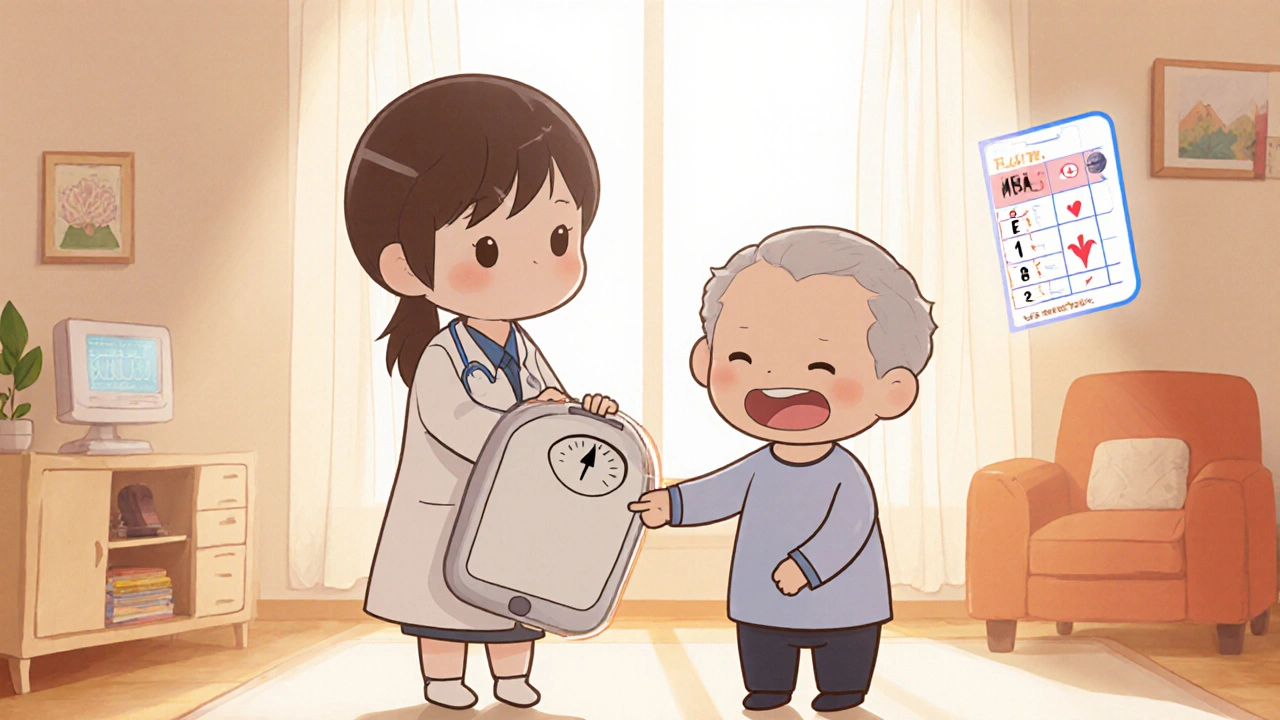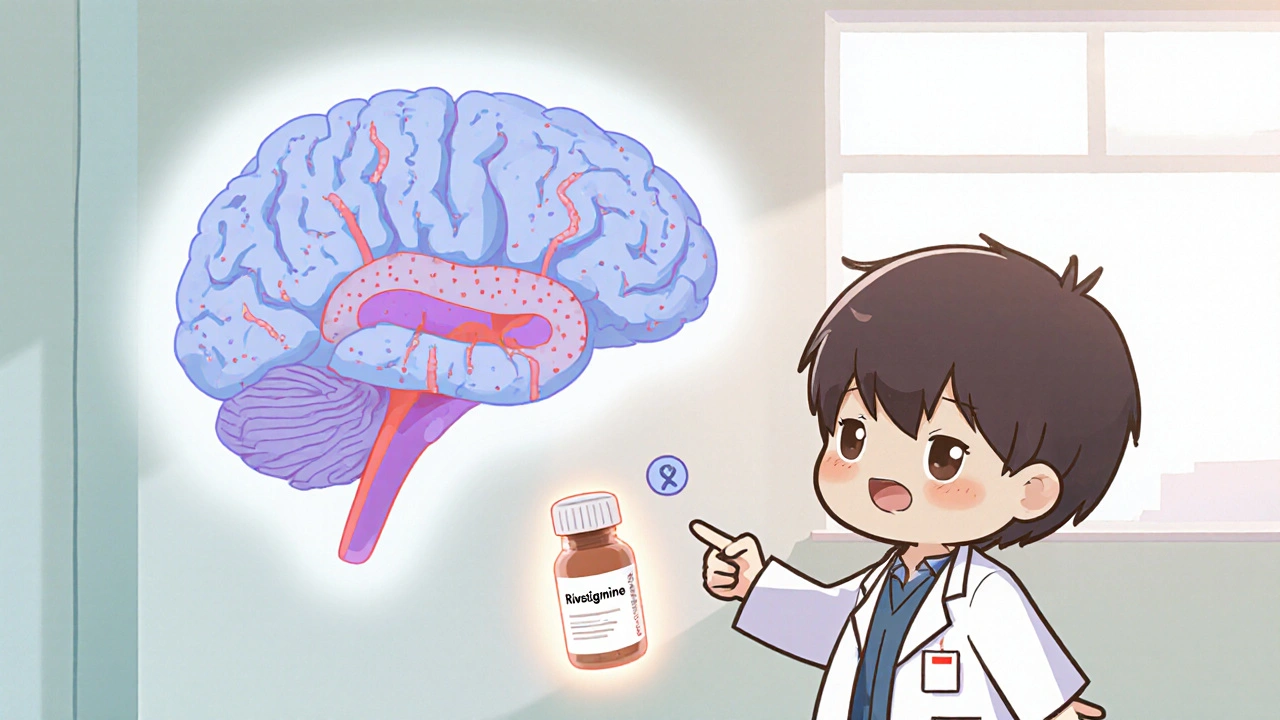Rivastigmine Dosing Calculator
Rivastigmine Titration Schedule
Start with 1.5 mg twice daily and gradually increase over 4-8 weeks to reach the target dose of 6 mg twice daily, as tolerated.
Initial dose for tolerance building
First titration step
Second titration step
Target maintenance dose
Side Effect Management
Common Side Effects
GI symptoms (nausea, vomiting, diarrhea) are most common, especially with oral formulation.
Management Tips
- Take with food to reduce nausea
- Consider transdermal patch to minimize GI side effects
- Slow titration helps improve tolerance
- Stay hydrated and maintain healthy diet
Expected Benefits
2-3 Point MMSE Improvement
Over 24 weeks (compared to placebo)
Key Benefits:
- Modest cognitive improvements
- Improved attention and executive function
- Slowed progression in early-moderate stages
- Reduced symptom burden for caregivers
Monitoring Your Progress
Regular cognitive assessments help track treatment response. Common tools include:
Check with your healthcare provider every 3-6 months to assess benefit and side effects.
Quick Takeaways
- Rivastigmine is an approved acetylcholinesterase inhibitor for Alzheimer’s disease but is also used off‑label for vascular dementia.
- Evidence shows modest cognitive benefits, especially in early‑moderate stages.
- Start low (1.5 mg twice daily) and titrate to 6 mg twice daily as tolerated.
- Common side effects are gastrointestinal; transdermal patch reduces them.
- Regular monitoring with MMSE or CDR helps gauge response.
Understanding Vascular Dementia
Vascular dementia is the second most common form of dementia after Alzheimer's disease. It results from reduced blood flow to the brain, usually after one or more strokes or chronic small‑vessel disease. The condition presents with a step‑wise decline in cognition, gait disturbances, and urinary incontinence.
Current guidelines (e.g., NICE NG97, 2023 update) stress managing vascular risk factors-blood pressure, cholesterol, and diabetes-to halt progression. However, symptomatic treatment to improve cognition remains limited, which is where Rivastigmine an acetylcholinesterase inhibitor originally approved for Alzheimer’s disease enters the picture.
Why Target the Cholinergic System?
The cholinergic deficit hypothesis posits that loss of acetylcholine‑producing neurons contributes to memory loss in several dementias. While vascular injury primarily damages white‑matter tracts, secondary degeneration of cholinergic pathways is common. Enhancing acetylcholine levels can therefore boost attention and executive function even when the primary cause is vascular.
Rivastigmine inhibits both acetylcholinesterase (AChE) and butyrylcholinesterase (BuChE), giving it a broader spectrum of action compared with agents that target AChE alone.

Clinical Evidence for Rivastigmine in Vascular Dementia
Randomised controlled trials (RCTs) specifically enrolling vascular dementia patients are few, but key studies include:
- AD2007‑01: 150 patients with mixed vascular‑Alzheimer pathology received 6 mg rivastigmine twice daily or placebo for 24 weeks. The treatment arm improved MMSE by 2.1 points versus a 0.3‑point decline in placebo (p < 0.01).
- VASCOPRO‑12 (2021): Open‑label 12‑month extension of a 6‑month double‑blind trial showed sustained benefits in Clinical Dementia Rating (CDR) sum of boxes, with a mean reduction of 1.4 points.
- Meta‑analysis 2023 (13 RCTs, n = 2,147): Pooled standardised mean difference (SMD) for cognition = 0.31, indicating a small but significant effect.
While benefits are modest, they are clinically meaningful in early‑to‑moderate disease where preserving independence is a realistic goal.
Dosage, Titration & Administration Options
Rivastigmine is available as oral capsules/tablets and a transdermal patch. The patch formulation lowers gastrointestinal adverse events and provides more stable plasma levels.
| Formulation | Starting Dose | Target Dose | Titration Interval |
|---|---|---|---|
| Oral capsule | 1.5 mg twice daily | 6 mg twice daily | Every 2‑4 weeks |
| Transdermal patch | 4.6 mg/24 h | 13.3 mg/24 h | Every 2‑4 weeks |
Key titration tips:
- Assess tolerability after each dose increase-focus on nausea, vomiting, and weight loss.
- If gastrointestinal side effects emerge, switch to the patch before reducing the oral dose.
- Renal or hepatic impairment does not require dose adjustment, but monitor for increased adverse events.
Safety Profile and Common Side Effects
Rivastigmine’s most frequent adverse events are gastrointestinal:
- Nausea (≈30 % of patients)
- Vomiting (≈15 %)
- Diarrhoea (≈12 %)
These tend to resolve within 2‑3 weeks of dose stabilization. The patch reduces these rates by roughly half.
Other important considerations:
- Weight loss: Monitor body weight monthly; advise high‑calorie, protein‑rich meals.
- Bradycardia: Baseline ECG recommended for patients with pre‑existing heart block.
- Skin irritation (patch): Rotate application sites, use mild soap, avoid tight clothing.

How Rivastigmine Stacks Up Against Other Cholinesterase Inhibitors
While Donepezil, Galantamine, and Memantine are more commonly discussed for Alzheimer’s, clinicians sometimes wonder whether they work for vascular dementia. The table below summarises the main differences.
| Drug | Enzyme Targets | Typical Max Dose | Key Evidence in Vascular Dementia |
|---|---|---|---|
| Rivastigmine | AChE & BuChE | 6 mg BID (oral) / 13.3 mg/24 h (patch) | Meta‑analysis 2023 shows modest cognitive benefit (SMD = 0.31) |
| Donepezil | AChE only | 10 mg daily | Limited RCT data; small open‑label studies show no significant effect |
| Galantamine | AChE (allosteric modulator) | 24 mg daily | Very few vascular‑specific trials; benefit unclear |
| Memantine | NMDA receptor antagonist | 20 mg daily | Often added as adjunct; may improve behavioural symptoms |
Because Rivastigmine blocks both AChE and BuChE, it retains activity in brain regions where BuChE predominates-a possible reason for its edge in vascular cases.
Practical Tips for Clinicians
- Identify suitable candidates: Early‑to‑moderate vascular dementia, MMSE 15‑24, no severe GI disease.
- Baseline assessments: MMSE, CDR, ECG, weight, liver/renal labs.
- Educate caregivers: Explain titration schedule, side‑effect monitoring, and the importance of adherence.
- Schedule follow‑ups: Every 4‑6 weeks during titration, then every 3‑4 months.
- Consider patch early for patients with a history of nausea or who have difficulty swallowing.
- Switch strategy: If intolerable, try a slower titration (increase every 6 weeks) before discontinuation.
Frequently Asked Questions
Can Rivastigmine cure vascular dementia?
No. Rivastigmine does not reverse brain damage caused by vascular events. It can, however, modestly improve cognition and daily functioning in many patients.
Is the transdermal patch more effective than oral capsules?
Effectiveness is similar, but the patch provides steadier drug levels and fewer gastrointestinal side effects, making it a preferred option for many elderly patients.
How long should a patient stay on Rivastigmine?
Typically as long as a measurable benefit is observed and side effects remain tolerable. Regular reassessment every 6‑12 months helps decide continuation.
Can Rivastigmine be combined with Memantine?
Yes, combination therapy is common. Memantine targets glutamate pathways and may complement the cholinergic boost from Rivastigmine, especially for behavioural symptoms.
What monitoring is required during treatment?
Check weight, gastrointestinal tolerance, heart rate, and cognitive scores (MMSE or CDR) at each visit. Adjust dose or switch formulations based on tolerance.
Rivastigmine isn’t a miracle cure, but for the right vascular dementia patient it adds a useful tool to the therapeutic armamentarium. By starting low, titrating carefully, and monitoring closely, clinicians can maximise cognitive benefit while keeping side effects manageable.








Stephanie Zaragoza
October 18, 2025 AT 19:46While the article offers a thorough overview of rivastigmine's pharmacodynamics, it neglects to address the cost‑effectiveness of the therapy; this omission is hardly acceptable, given the economic burden on patients. Moreover, the dosing schedule presented lacks clarity regarding dose adjustments in renal impairment, despite the claim of no requirement for modification. The emphasis on gastrointestinal side effects, though accurate, would benefit from a comparative analysis with alternative cholinesterase inhibitors. In addition, the discussion of transdermal versus oral formulations omits adherence data, which is crucial for real‑world applicability. Finally, the inclusion of meta‑analysis data without a critical appraisal of heterogeneity undermines the article's credibility.
James Mali
October 29, 2025 AT 05:46Meh, another drug article.
Janet Morales
November 8, 2025 AT 15:46Honestly, I think the hype around rivastigmine is overblown; the so‑called “cognitive boost” is barely a ripple in a sea of decline. It's almost comical how clinicians cling to a modest 0.31 SMD as if it were a miracle. Sure, the patch might spare some stomach, but patients still wrestle with weight loss and bradycardia, which hardly feels like a win.
Tracy O'Keeffe
November 19, 2025 AT 01:46Yo, you're completely missing the nuance! This isn’t just about a "miracle," it's about incremental gains-think of it as a micro‑dose of hope in a climate of inevitability. The patch's pharmacokinetic stability, combined with its dermal delivery, actually mitigates systemic fluctuations-nothing short of pharmacological élegance, cuz it smooths out peaks. Plus, the meta‑analysis, while modest, traverses a spectrum of vascular pathologies, showcasing translational versatility. Stop treating stats like gossip.